
Portraits from the Trench
“My ancestors came to collect me from a dream
never designed to include me.”
Part of the Rematriating Borikén Project, Portraits from the Trench is a painting series documenting individuals on the rematriation journey. Inspired by the Puerto Rico Trench and the bioluminescence of the abyss, I paint on black backgrounds channeling the aesthetics described in the Rematriating Borikén Manifesto. Written in 2019 to commemorate my fifth year living in Borikén, the manifesto envisions the rematriation journey as an underwater initiation, crossing sands submerged towards rescuing our ancestral and authentic ways.
In 2024, to commemorate ten years living in the archipelago, I created a series of portraits of folks on their rematriation journeys. Painted on black velvet, these portraits are reminiscent of the black power/ black velvet/ black light aesthetics of my Brooklyn childhood and of the bioluminescence that is prevalent in our archipelago. I also incorporate sequins simulating scales (though scales are not necessarily seen on deep-sea fish) and mother of pearl, all which catch and reflect light. Some of the paintings feature calligraphy excerpts from interviews I did in preparation for each portrait at CucubaNación, my bioluminescence-inspired studio and gallery in Mayaguez, Puerto Rico. Testimonials to rematriation as a decolonial practice, they are informed by our daily lived experience. The portrait series combines individuals who have always lived on and cared for these lands; those who, for various reasons, had to leave the archipelago and chose to return; and folks from the Diaspora arriving to reconnect. They range in age from their twenties to seventies and represent queer, trans and cis hetero folks. This virtual gallery traces the project’s progression from its inception in 2019, through the 2020 earthquakes and the pandemic shutdown, to the 2023 NALAC Fund for the Arts grant that enabled the expansion of the project with the Studio Sessions interviews and the portraits on black velvet. Portraits from the Trench is currently on view at CucubaNación in Mayagüez pueblo.
Gratitude to the National Association of Latino Arts & Cultures for supporting the research and development for this painting series.
"Inter-ocean, Cosmic Marine Species," 2023. Yasmin Hernandez, Portraits from the Trench. Acrylic on black velour, 59 x 53 inches. "We, another interocean, cosmic, marine species of colonial refugees emerge like mermaids from the sea.” -Excerpt, Rematriating Borikén Manifesto This painting combines portraits of Susimar, Max, Lilly, Leo, Janía, & Rosie, all on the rematriation journey, currently living in el oeste de Borikén. The first half left Puerto Rico and returned, the latter three moved to the archipelago from New York and Boston. After receiving the NALAC grant for the creation of the portraits on black velvet, I began the interviews in preparation for the paintings. These were the first people to be interviewed in the Studio Sessions at CucubaNación, my studio/ art space in Mayagüez, against a black background and lighting evoking the bioluminescence of the abyss. Channeling the abyss is a metaphor for navigating the darkness of colonialism, power outages and climate change. As the first painting of this series not created on canvas, it was an exploration of the fabric and different techniques around lighting.
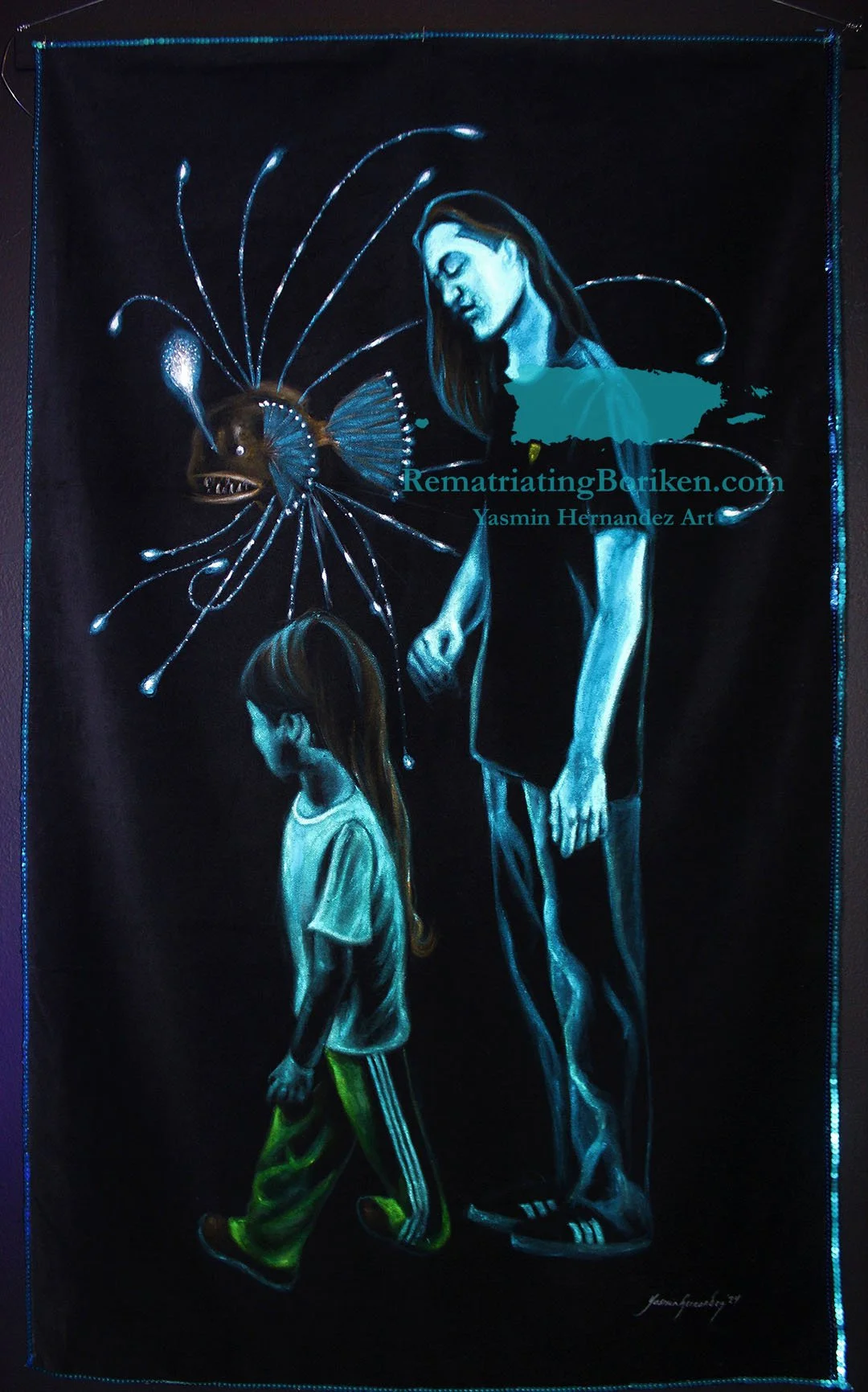
"515" (Gabriel), 2024, Yasmin Hernandez. Portraits from the Trench, Acrylic and sequins on black velvet. 40 ¾ x 29 ½ inches. This double portrait of my son Gabriel marks his age when we arrived, five, and his age at the time of our tenth anniversary, fifteen. We arrived in the archipelago from New York when he was five, in search of a school where he would start Kindergarten. 515 is also a reference to the day we moved: May 15, 2014. The ferocious angler fish with beautiful bioluminescent filaments is the female, a hovering, protective, fierce maternal presence. It is the animal he chose to have represented in his painting and reminds me of the many iterations of motherhood that I have had to embody through the transitions of the move, through hurricanes, apagones, pandemic, earthquakes and more.

"Ser el abismo", (Ketsia), 2024. Yasmin Hernandez, Portraits from the Trench. Acrylic and sequins on black velvet, 36 x 30 inches. “Nos hemos tenido que lanzar a ese abismo, a esa nada, a ese desconocimiento, a esa incertidumbre tantas y tantas veces… ¿Como yo puedo también ser el abismo… ser esa trinchera?... la respuesta es ese cimarronaje…. Que se escapaba de la hacienda, inventaba nuevas formas de vida en un monte. Por eso para mi me llama un monte también.” -Excerpt, interview with Ketsia, April, 24, 2024. (Translation: We have had to lunge into that abyss, that nothingness, that unknown, that uncertainty time and time again. How can I too be the abyss, be that trench? The answer is in that maronage, where one would escape from the plantation, invent new ways of life on a mountain. That is why I too am drawn to the mountain.) Likening life in a colony to being forced to face or lunge into the abyss each day, Adjuntas-born and raised artist/ poet Ketsia Camacho Ramos turns to the strategy of learning to become the abyss itself. Learning how to navigate darkness, when to go under the radar and when to emerge from the depths. Requiring one to descend from los montes to the urban centers to study or work becomes the precursor to the ultimate displacement of being forced off the archipelago altogether. Like I longed for Borikén back in Brooklyn, Ketsia, based in Mayagüez, lives with the desire to return to her Adjuntas monte one day.
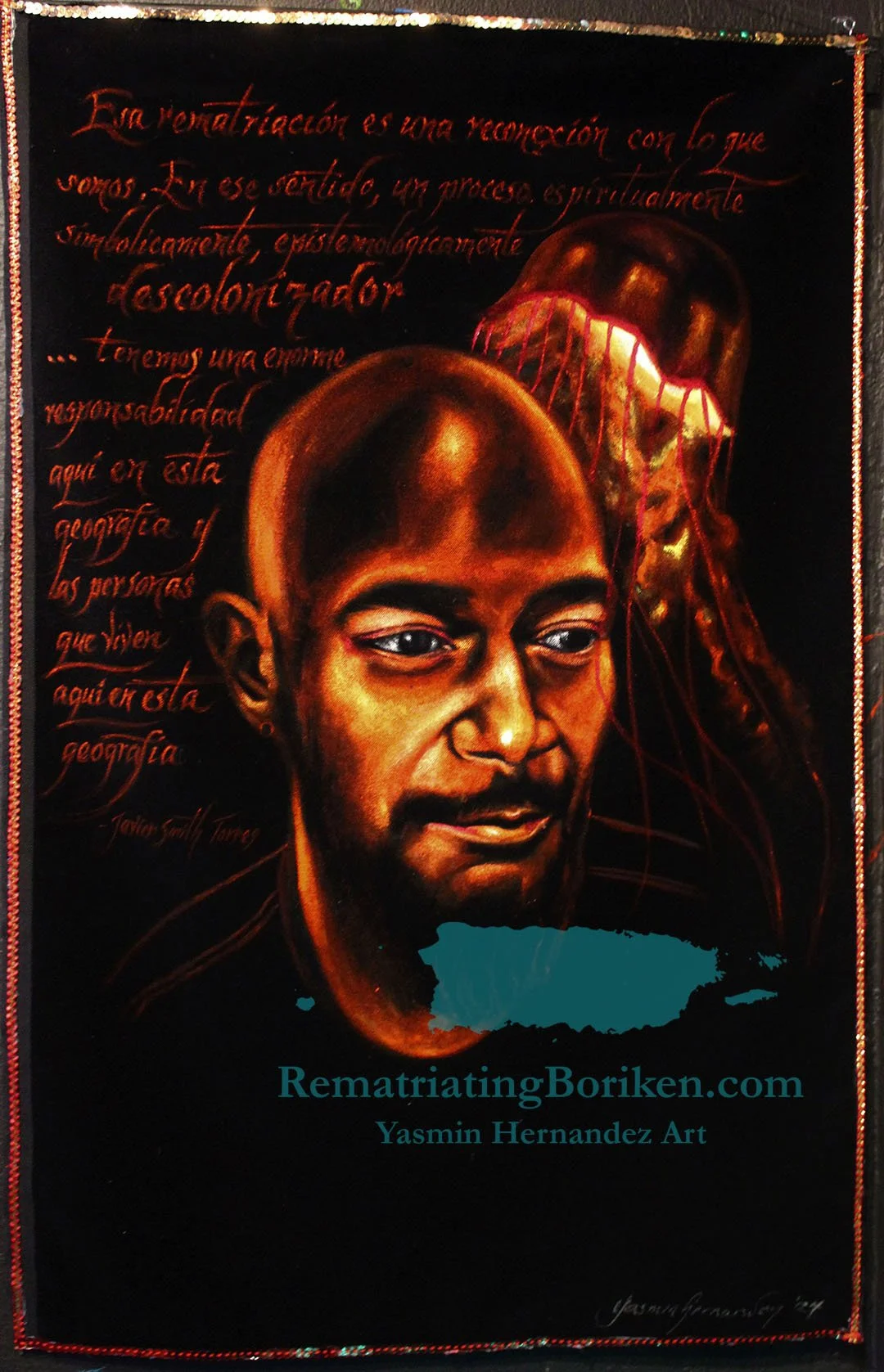
"La rematriación descolonizadora" (Javier), 2024. Yasmin Hernandez, Portraits from the Trench. Acrylic and sequins on black velvet 29 ½ x 19 ½ inches “Esa rematriación es una conexión con lo que somos. En ese sentido es un proceso espiritualmente, simbólicamente, espistemológicamente descolonizador.” -Excerpt, interview with Javier Smith Torres, May 2024. (Translation: That rematriation is a reconnection to what we are. In that sense, it is a process that is spiritually, symbolically and epistemologically decolonial.) Javier’s heritage extends from Borikén to the Virgin Islands. He returned to the archipelago from New York to pursue his dream of studying at RUM, the University of Puerto Rico’s Mayagüez campus. Now based in the archipelago, he is committed to the decolonization struggle. In his interview, going on to discuss the crucial contributions of the Diaspora, he affirms the “enormous responsibility that we have to this geography,” referencing the archipelago and the people who live here.

"Quiero mi cantito de tierra" (Max), 2024 Yasmin Hernandez, Portraits from the Trench. Acrylic and sequins on black velvet, 32 x 31 ½ inches. “Rematriación también tiene que venir del sentido de tu poder tener un espacio y sentirte parte, tener tu casa y también así empezar a soñar... Quiero mi cantito de tierra... es mi derecho y el derecho de nosotres estar en nuestro cantito de tierra.” -Excerpt, interview with Maximilián Adrián, summer 2023 Translation: Rematriation also has to come from being able to have a space and a sense of belonging, have your house and that way begin to dream... I want my little piece of land... it is my right and our right to be on our own little piece of land. Maximilián Adrián had to leave Puerto Rico following Hurricane María. He returned two years later, still feeling he belonged to the archipelago, but feeling he was a part of the Diaspora as well. In his interview, he also recounted his experience going through FEMA hotels in New York and the reasons why it is so necessary to have a right to housing upon returning. He also emphasized the specific struggles around queer and trans people and their need for a safe, sanctuary space to call home, and to feel a sense of belonging.

"La bomba me sostiene" (Janía), 2024. Yasmin Hernandez. Portraits from the Trench. Acrylic and sequins on black velvet, 29 ¾ x 50 inches. “En mis años de (re)matriar en esta tierra, he podido describer montes, costas y horizontes que mi abuela misma no pudo apreciar. Es ahí en esos momentos cuando observo un atardecer, cuando me sumerjo en un mar turquesa, cuando me acaricia la brisa de los montes es que descubro que mis ancestres tuvieron que irse para yo econtrarme aquí.” -Excerpt, interview with Janía, summer 2023 (Translation: In my years of (re)matriating this land, I’ve been able to describe mountains, coasts and horizons that my own grandmother was not able to appreciate. It is there in those moments when I observe a sunset, when I immerse myself in a turquoise sea, when the cool breeze of the mountains caresses me that I discover that my ancestors had to leave for me to find myself here. In Janía’s own words: I was born and raised in Boston, Massachusetts. I moved to Borikén when I was eleven years old. Although I’ve been living in Borikén for thirteen years, it wasn’t until I was twenty-three years old that I came to acknowledge and understand that here is where I needed to be. That’s when my rematriation started; the moment I decided that even though living on this tropi-colonia (and all that it implies) has not been easy, I couldn’t see myself wanting to be anywhere else. Being the only person of my immediate family that lives, survives and resists on this archipelago may be a burden for others, but is a purpose for me.
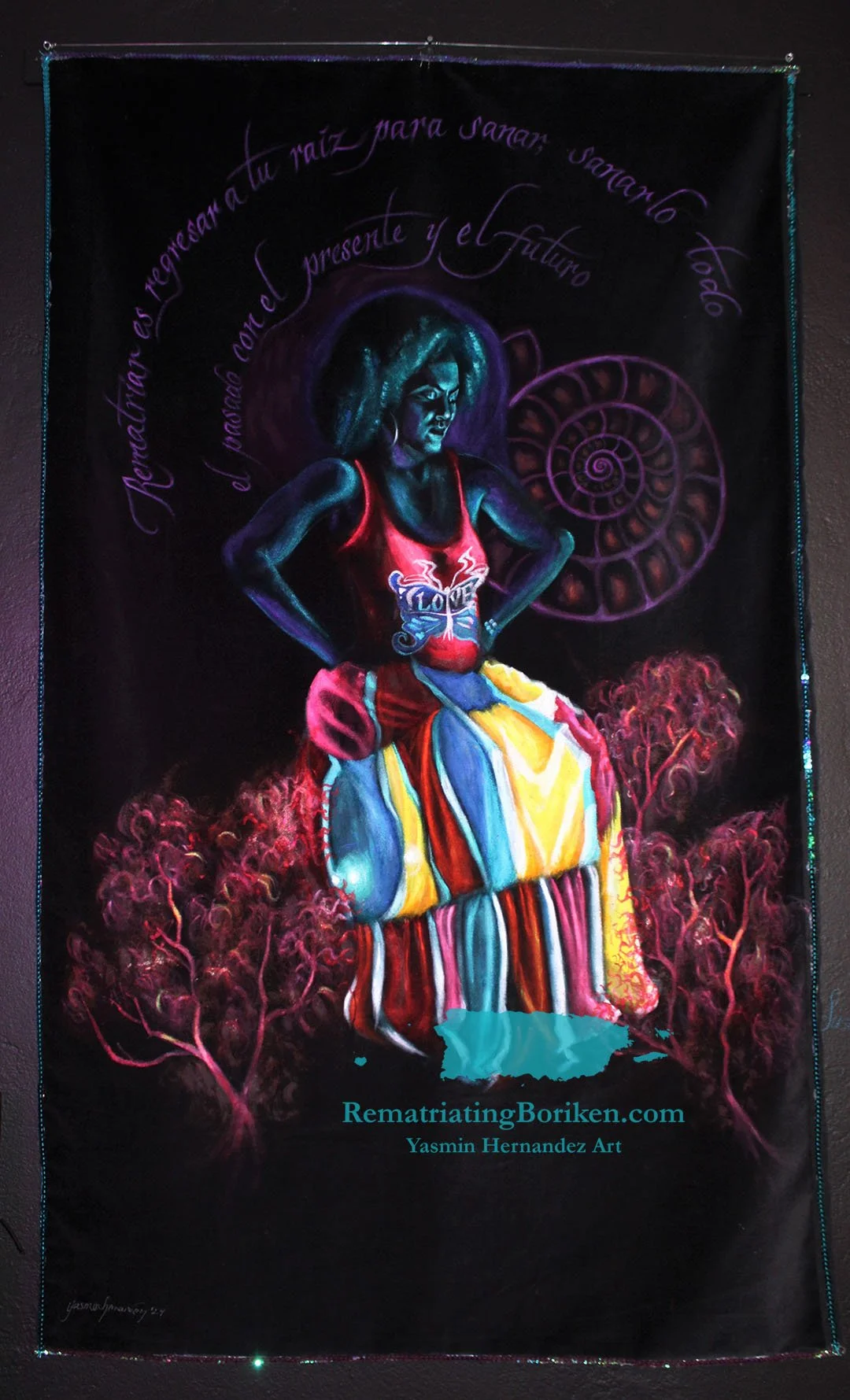
"Regresar a tu raíz" (Susimar), 2024. Yasmin Hernandez, Portraits from the Trench. Acrylic and sequins on black velvet, 47 ½ x 30 inches. “Rematriar es regresar a tu raíz para sanar, sanarlo todo, el pasado con el presente y el futuro.” -Excerpt, interview with Susimar González Martínez, Summer 2023. (Translation: To rematriate is to return to your root to heal, to heal it all, the past with the present and the future.) This image is taken from Susi’s Studio Session interview. She arrived wearing this spectacular skirt which created all sorts of effects with the nearby black light. I chose this pose with her fists on her hips, that she naturally took during her interview, because together with the skirt, it reminded me of madamas, ancestral spirit guides whose presence and images I grew up with in my family. Having studied in the archipelago and in Brazil towards a pharmaceutical degree, after living in South Carolina for several years, Susi returned to Borikén following Hurricane María. Originally from Toa Alta, she now runs a farm in Moca, committing to her love of plants and teaching traditional, ancestral farming practices. Susi chose deep-sea coral as her featured abyss organism which in some cases resemble plants.
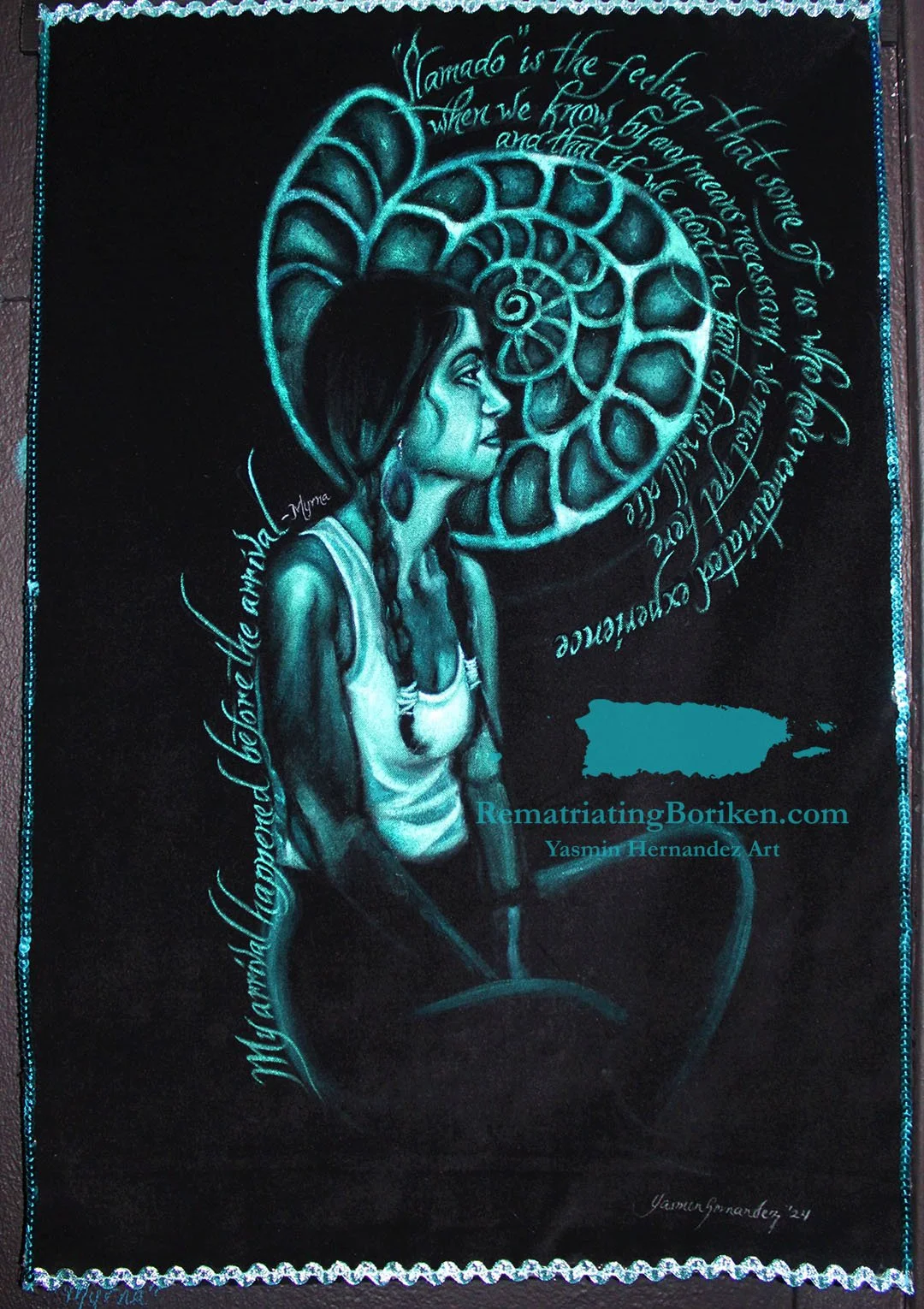
"Arrival" (Myrna), 2024, Yasmin Hernandez. Portraits from the Trench, Acrylic and sequins on black velvet, 30 x 20 ½ inches. “My arrival happened before the arrival... Llamado is the feeling that some of us who rematriate experience when we know, by any means necessary, we must get here and that if we don’t a part of us will die.” -Excerpt, interview with Myrna Cabán Lezcano February 2024 Myrna is a community herbalist, educator, cultural organizer and the creator of Sánate Boricua, a collective working to bring ancestral medicine, healing clinics and wellness workshops to our people in el oeste de Borikén. At the time of our interview, Myrna had just completed her first year in the archipelago and was able to provide insight from a very fresh perspective from the Diaspora and the impact of her observations of life in the archipelago. Within that first year, Sánate Boricua was already up and running, offering spaces for collective healing practices.

"Reclaiming the Matriarchal" (Meli), Yasmin Hernandez. Portraits from the Trench. Acrylic and sequins on black velvet, 29 ½ x 19 ½ inches. “The difference between repatriation and rematriation is that focus on reclaiming or restoring the matriarchal wisdom.” -Excerpt, Interview with Melissa Rosario, March 2024 One of the early voices lifting the term rematriation in the archipelago, Melissa, originally from New York, is the author of Another Country: A Counter History of Puerto Rico in Crisis and co-founder and co-director of CEPA, a healing justice project committed to decolonization. Meli’s interview did not take place at my studio but at la Casa taller de CEPA en Río Piedras before a large Palestinian flag and surrounded by all the ancestral plants that they themselves have planted. Working with embodied practices and the reinserting of one’s body back in the ancestral lands, as Meli describes it, I was struck by the oasis they had forged in the middle of an urban area. CEPA hosts solidarity visits for folks from the Diaspora committed to healing as a liberation practice and wishing for a space to reconnect and build in the archipelago.
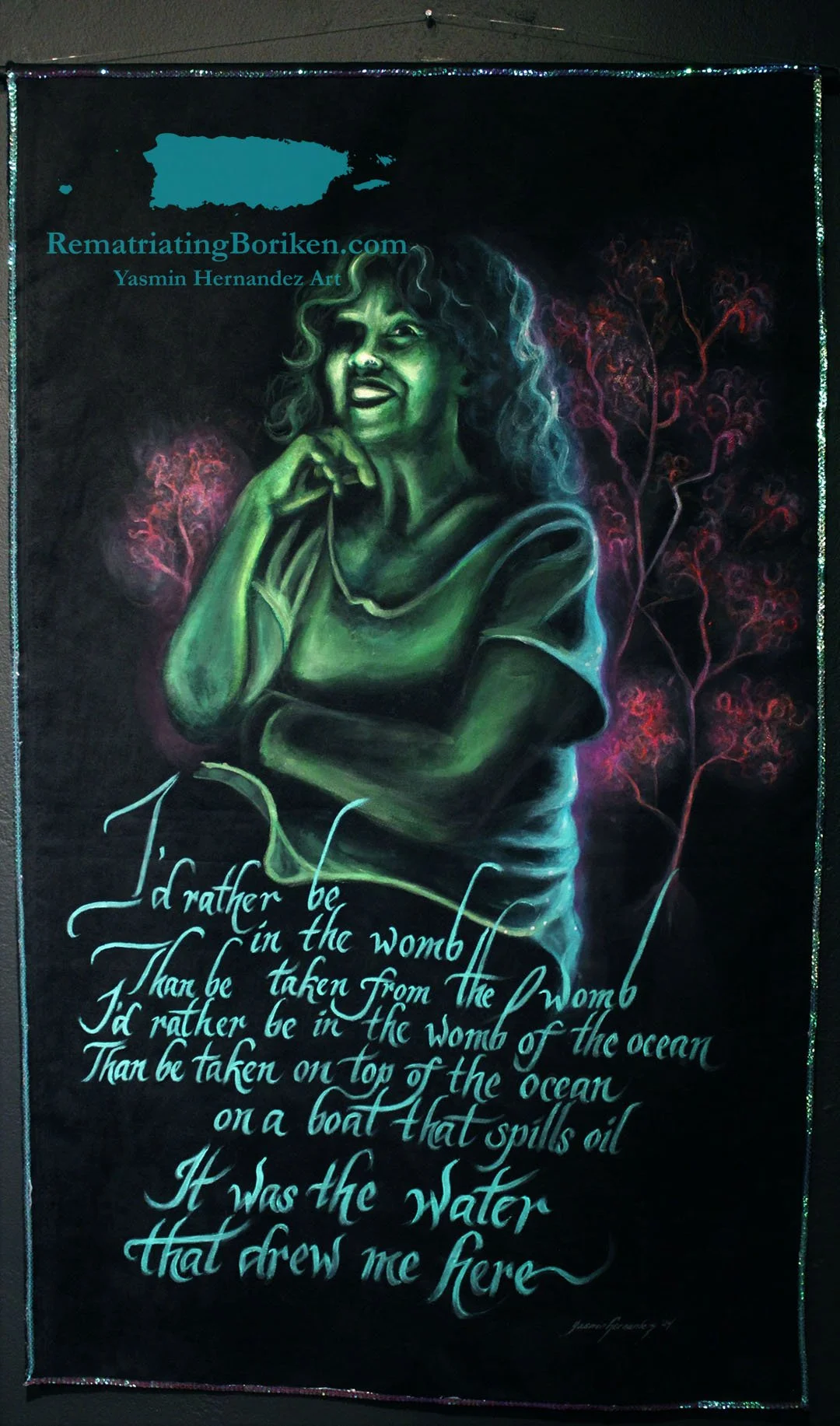
"I’d Rather Be in the Womb" (Rosie), 2024. Yasmin Hernandez. Portraits from the Trench. Acrylic and sequins on black velvet, 48 x 29 ½ inches. “I’d rather be in the womb than be taken from the womb. I’d rather be in the womb of the ocean than be taken on top of the ocean on a boat that spills oil... It was the water that drew me here.” -Excerpt from interview with Rosie Díaz, Summer 2023. Born and raised in the Bronx, Rosie has been living in the archipelago for over thirty years. Back when she lived in Seattle, an accident left her unable to walk. With the help of a massage therapist, she fully recovered. Inspired to become a massage therapist too, she moved to the archipelago to bring her healing practice to her people. She credits the waters off Playa Jobos in Isabela as luring her here, where she continues her love for dancing and playing bomba, and teaches yoga. Rosie has been a consistent presence in my family’s life throughout my rematriation journey and has also helped my mother with her transition here.
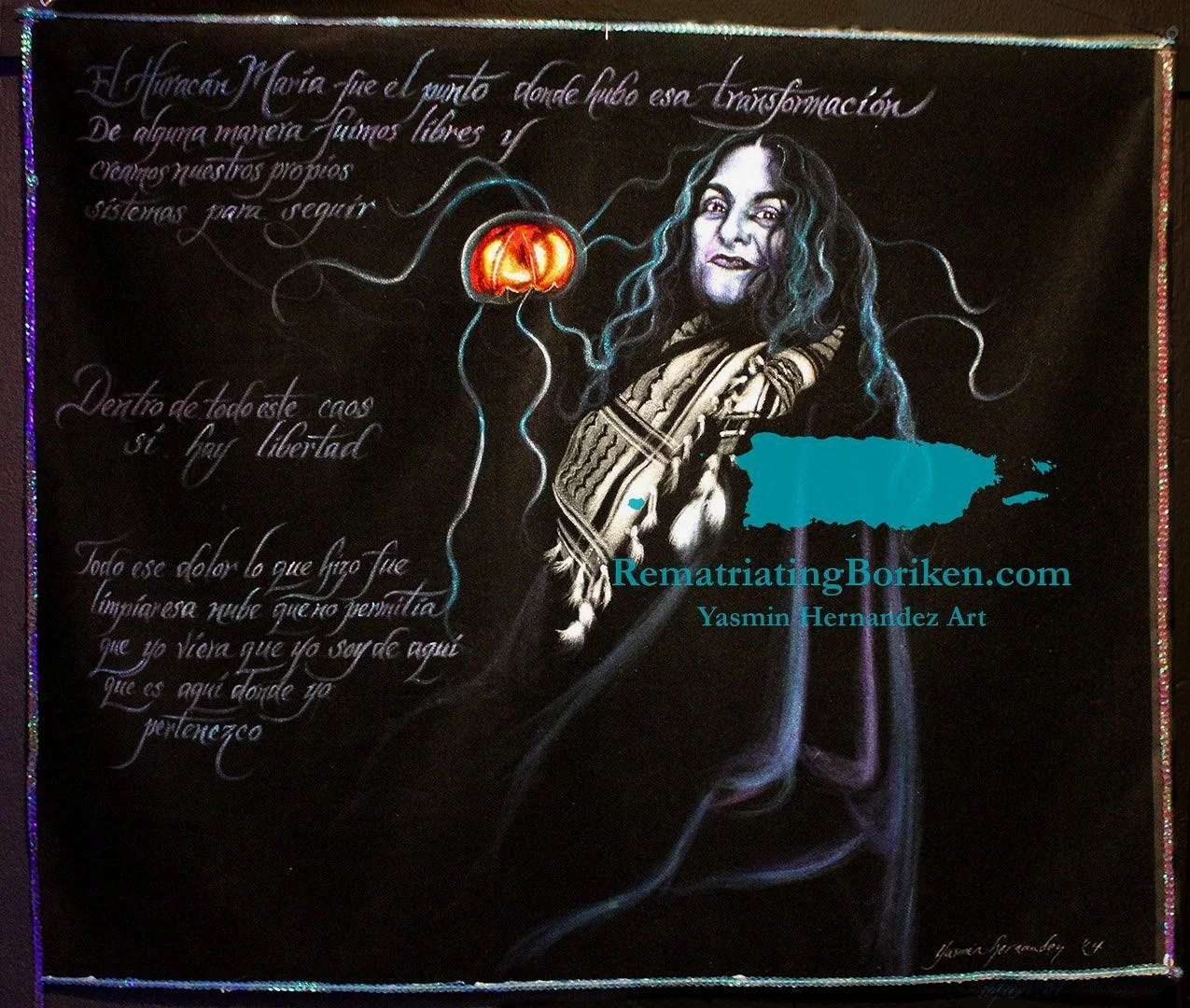
"Es aquí donde yo pertenezco" (Marisol), 2024. Yasmin Hernandez. Portraits from the Trench. Acrylic and sequins on black velvet. “El Huracán María fue el punto donde hubo esa transformación. De alguna manera fuimos libres y creamos nuestros propios sistemas para seguir... Dentro de todo este caos, sí hay Libertad... Todo ese dolor lo que hizo fue limpiar esa nube que no permitia que yo viera que yo soy de aquí, que es aquí donde yo pertenezco. Translation: (Hurricane María was that point of transformation. In some way we were free and created our own systems to move forward.... Within all that chaos, yes there is freedom... What all of that pain did was clean that cloud that didn’t allow me to see that I am from here, that it is here where I belong.) -From Marisol's interview Feb 2024 Marisol came to her Studio Session interview with this keffiyeh, wanting to ensure that she represented her solidarity with the people of Palestine. The keffiyeh was gifted to her by a Palestinian friend in San Sebastián, where they live. Way before October 7, 2023, the first Nakba in 1948 led to the mass displacement of Palestinians. Puerto Rico is a part of that Diaspora with a significant Palestinian community.

"El coraje me sostiene" (Yarí) 2024. Yasmin Hernandez. Portraits from the Trench. Acrylic and sequins on black velvet. 29 1/2 x 24 1/2". Yo vivo con coraje, vivo con dolor. Amor a mi país. Y yo creo que lo que me sostiene aquí es que me rehuso a que a mi me vuelvan a desplazar. (Translation: I live with rage, live with pain. Love for my country. And I think that what sustains me here is that I refuse to be displaced again.) Yarí's interview speaks to the colonial conditions that we live in Puerto Rico and to the role of rage in sustaining her here, and driving her work and mission here. Yarí is also an artist, dancer and farmer.

"One Womb to the Next." (Matthew), 2024. Yasmin Hernandez. Portraits from the Trench. Acrylic and sequins on black velvet. "Learning about my history has helped me reframe the traumas of relocation from one womb to the next."... "My balcony looks out over Cerro Pichón in San Sebastián so I see where my family is from every time I wake up. I look out and there it is. There’s my Wakanda." -From Matthew's interview, March 2024. Born in New York, raised in Florida, now living in San Sebastián, Matthew chose the siphonophore as his abyss creature. These fascinating creatures are not singular at all but a community of organisms forming a chain, working together symbiotically. My marine biologist friend Thay, upon seeing the portrait, shared that siphonophores announce approaching storms when they rise to the surface. Matthew was born on the night of Hurricane Gloria, the first hurricane I remember experiencing in New York as a child.
Rematriating Borikén
-
Rematriating Borikén is a project documenting and lifting rematriation in the archipelago. Celebrating the life long stewards preserving the ancestral essence of these lands, those who have returned after an extended absence, and those who arrive from the Diaspora to live here for the first time.
-
Listen to the Rematriating Borikén Podcast on You Tube.
-
Read the Rematriating Borikén Manifesto on the project website.
-
Yasmin reads the Rematriating Borikén Manifesto on the project Podcast.
-
-
